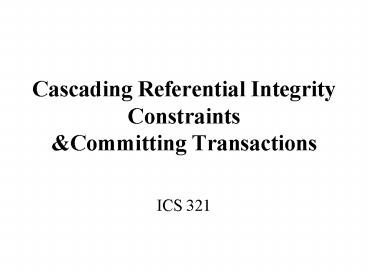Cascading Referential Integrity Constraints PowerPoint PPT Presentation
1 / 9
Title: Cascading Referential Integrity Constraints
1
Cascading Referential Integrity
ConstraintsCommitting Transactions
- ICS 321
2
Cascading Referential Integrity Constraints
- Cascading referential integrity constraints allow
you to define the actions Microsoft SQL Server
2000 takes when a user attempts to delete or
update a key to which existing foreign keys
point. - The REFERENCES clauses of the CREATE TABLE and
ALTER TABLE statements support ON DELETE and ON
UPDATE clauses - ON DELETE CASCADE NO ACTION
- ON UPDATE CASCADE NO ACTION
3
NO ACTION
- NO ACTION is the default if ON DELETE or ON
UPDATE is not specified. NO ACTION specifies the
same behavior that occurs in earlier versions of
SQL Server. - ON DELETE NO ACTION
- Specifies that if an attempt is made to delete a
row with a key referenced by foreign keys in
existing rows in other tables, an error is raised
and the DELETE is rolled back. - ON UPDATE NO ACTION
- Specifies that if an attempt is made to update a
key value in a row whose key is referenced by
foreign keys in existing rows in other tables, an
error is raised and the UPDATE is rolled back.
4
CASCADE
- CASCADE allows deletions or updates of key values
to cascade through the tables defined to have
foreign key relationships that can be traced back
to the table on which the modification is
performed. CASCADE cannot be specified for any
foreign keys or primary keys that have a
timestamp column.
5
ON DELETE CASCADE
- Specifies that if an attempt is made to delete a
row with a key referenced by foreign keys in
existing rows in other tables, all rows
containing those foreign keys are also deleted.
If cascading referential actions have also been
defined on the target tables, the specified
cascading actions are also taken for the rows
deleted from those tables.
6
ON UPDATE CASCADE
- Specifies that if an attempt is made to update a
key value in a row, where the key value is
referenced by foreign keys in existing rows in
other tables, all of the foreign key values are
also updated to the new value specified for the
key. If cascading referential actions have also
been defined on the target tables, the specified
cascading actions are also taken for the key
values updated in those tables.
7
- Committing Transactions
- Unlike many other relational DBMS products such
as Oracle, SQL Server automatically commits after
every INSERT, DELETE, or UPDATE operation. - One option for controlling when transactions
commit is to use explicit transaction
specifications by grouping SQL statements within
transaction delimiters BEGIN TRANSACTION and
COMMIT TRANSACTION.
8
- Committing Transactions Contd.
- BEGIN TRANSACTION
- DELETE FROM employee
- WHERE emp_ssn '999111111'
- DELETE FROM employee
- WHERE emp_ssn '999444444'
- COMMIT TRANSACTION
- The BEGIN TRANSACTION statement begins an
explicit transaction. Two employee rows are
deleted, but the change to the database does not
take place until the COMMIT TRANSACTION statement
processes. - At any point prior to execution of COMMIT
TRANSACTION, the ROLLBACK TRANSACTION statement
can be used to cancel the deletions that are
in-process.
9
(No Transcript)

